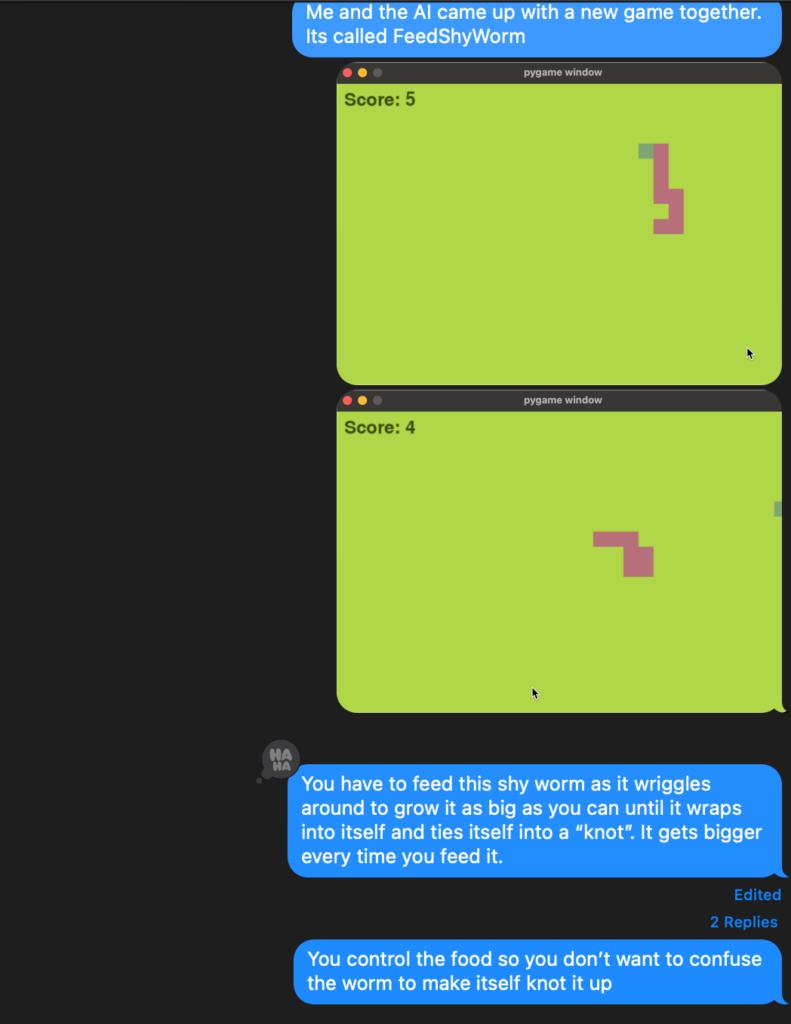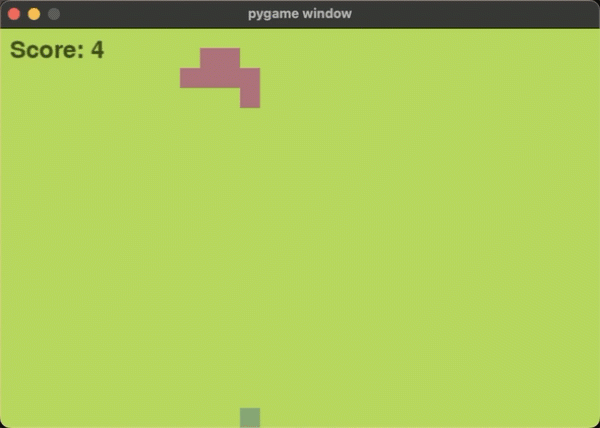
You can follow the actual conversation through this link: ChatGPT – Collaboration with AI on new game(openai.com)
gist of referenced code: https://gist.github.com/kody-w/019b788107b359dc7cf10fe477bb17a4
replit: feedShyWorm.py – Replit
Game GIF explanation: player is moving the grey dot (the food) to try and make impact with the worm’s “head” block. If that happens you get one point. Try to get as many points as you can but the heat gets turned up when the worm continues to grow with each piece. The highest score I have been able to achieve before knotting up is 8 (so far!).

When we dive into the realm of artificial intelligence (AI), we often find ourselves at a crossroads of potential and partnership. It’s a dance between the algorithmic agility of AI and the nuanced intuition of human creativity. Recently, I embarked on a project that exemplified this synergy, breathing new life into the classic ‘Snake’ game by reimagining it as “FeedShyWorm.”
The Genesis of “FeedShyWorm”
Like a nostalgic tune remixed for a new generation, “FeedShyWorm” reinvigorates the simple joy of the ‘Snake’ game with a twist—here, the player tempts a worm with food, indirectly steering its growth and ensuring its survival. The challenge? To grow the worm without entangling it into a self-made knot.
The Symbiotic Workflow
AI provided a solid foundation for the game’s development, offering a library of coding patterns and potential solutions. From rendering the game window to defining the worm’s wriggling motion, AI-generated pseudo-code laid out a clear path forward. Yet, it was human oversight that steered the project, filtering through the AI’s suggestions to find the perfect blend of innovation and tradition.
AI: The Technical Muse
In this collaboration, AI shone as a technical muse, suggesting complex algorithms for the worm’s growth and navigation. It handled pathfinding and error resolutions, effortlessly juggling logical structures to suggest efficient and robust solutions.
Human: The Creative Conductor
The human element brought irreplaceable intuition and judgment to the table. From the game’s initial concept to its final nuances, it was the human touch that molded AI’s raw output into a game that’s engaging and enjoyable. The decision to make the worm grow by two blocks with every piece of food and to introduce a game-over condition based on consecutive self-collisions came from a place of understanding the player’s experience—something AI is yet to grasp fully.
The Perfect Pairing
The crazy thing is this work took just a few hours of this collaboration work. If I were to do this task just by itself, I would have to invest A LOT more time to get the same result and I would argue that it is trivial work compared to delivering the actual value of the game.
The true beauty of “FeedShyWorm” lies in its balance. AI’s strength in handling the complexities of code is paired with the human ability to infuse emotion and appeal into the game. The AI proposes, the human disposes, and the result is a game that respects the player’s intelligence and capacity for strategy.
Conclusion: The Harmonious Blend
“FeedShyWorm” is a testament to the potential of human-AI collaboration. AI’s contributions are invaluable, but without human ingenuity, they are merely pieces of a puzzle waiting to be put together. This case study exemplifies the most optimal use of AI—to amplify human creativity, not replace it. Together, they unlock new dimensions of innovation, leading to outcomes that are greater than the sum of their parts.
As we move forward, “FeedShyWorm” stands as a prime example of this collaboration process, showcasing that the best way to harness AI is in tandem with the unique aspects of human creativity. Here’s to many more human-AI partnerships, where we explore uncharted territories with the wisdom of experience and the insights of intelligence—artificial and otherwise.
Until next time, remember—it’s not just about the code; it’s about crafting experiences. Experiences that teach us, entertain us, and most importantly, bring us together.
